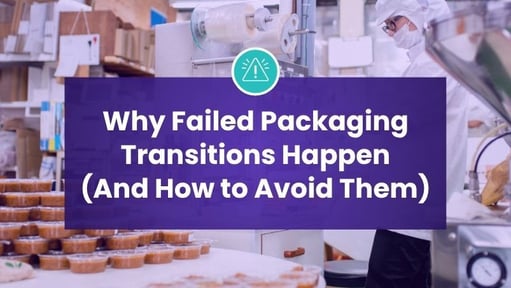 Packaging transitions are rarely as simple as they appear on a project timeline. Whether driven by sustainability initiatives, performance upgrades, or material availability, changing packaging materials can create unplanned disruptions if not properly managed. At ICPG, we’ve seen how even the best-intentioned changeovers can stall if execution doesn’t match the complexity of production.
Packaging transitions are rarely as simple as they appear on a project timeline. Whether driven by sustainability initiatives, performance upgrades, or material availability, changing packaging materials can create unplanned disruptions if not properly managed. At ICPG, we’ve seen how even the best-intentioned changeovers can stall if execution doesn’t match the complexity of production.
Understanding the root causes of failed packaging transitions can help teams take a more informed and effective approach. Below are five of the most common breakdown points, and how to mitigate them.
1. Insufficient Planning Upfront
Many packaging changeovers begin with enthusiasm but lack a defined roadmap. Teams may initiate trials before aligning on key requirements like forming specifications, barrier needs, sealing conditions, or downstream automation compatibility.
Without clarity around technical expectations, timelines quickly slip, multiple test rounds are required, and material waste increases.
What to do instead:
- Define success criteria early—this includes forming specs, seal strength, barrier properties, and regulatory compliance
- Involve internal technical teams and material suppliers from the start
- Document operational constraints such as existing equipment and downstream automation requirements
At ICPG, we prioritize early-stage alignment so materials are engineered with the end-use environment in mind.
2. Overlooking Process Compatibility
No two materials behave the same under heat, pressure, or speed. A resin that looks identical on paper may process very differently in extrusion, thermoforming or form fill seal affecting forming windows, seal behavior, and clarity.
Failure to account for these variations can result in downtime, seal failures, or rejected products—some of the most common outcomes in failed packaging transitions.
What to do instead:
- Conduct both lab-scale and full-scale trials using equipment that replicates production conditions
- Reviewing forming, cutting, and sealing data from the material supplier
- Confirm compatibility with existing technology and line speeds
At ICPG, every new formulation is tested on production-scale extrusion lines and undergoes forming simulation testing before it ever reaches a customer trial ensuring predictable results on day one.
3. Supplier Misalignment
A packaging transition is only as strong as the collaboration behind it. When communication breaks down between converters, suppliers, and brand owners, small misunderstandings can snowball, and technical details can be misinterpreted or lost.
The result is often mismatched specs, delayed validation, or last-minute redesigns.
What to do instead:
- Select suppliers that operate as technical collaborators, not just vendors
- Establish shared documentation and version control for specs
- Hold regular alignment calls during development and testing
ICPG’s process was built around partnership from co-development in R&D to on-site technical support during customer trials.
4. Sustainability Prioritized Over Performance
Sustainable packaging solutions are a priority across the industry, but decisions made solely on recyclability can backfire. In the rush to “go green,” teams sometimes select materials based on recyclability claims alone, only to find that performance, process efficiency, or cost suffer downstream.
This disconnect often leads to packaging that satisfies marketing claims but fails in production or distribution.
What to do instead:
- Evaluate sustainability within the context of performance and cost
- Consider recyclability, material yield, energy use, and density together
- Select materials that meet recyclability goals without compromising run efficiency
ICPG materials such as XPP and RE-BA are engineered to support sustainability without sacrificing processability or shelf performance.
5. Skipping Real-World Validation
Lab testing is a valuable starting point, but it doesn’t replicate the full lifecycle a package will experience. Without validation under real-world conditions, unforeseen issues can emerge post-launch.
These failures can impact product integrity, shelf stability, and customer satisfaction.
What to do instead:
- Conduct full lifecycle testing, including sealing, distribution, and storage
- Confirm recyclability under targeted stream conditions
- Conduct controlled field trials before commercial rollout
ICPG supports customers through technical validation, helping ensure new materials meet operational and market requirements.
The Bottom Line: Plan for Reality, Not Perfection
Most failed packaging transitions result from planning around assumptions rather than production realities. By aligning early, validating thoroughly, and working with partners who understand the full process, teams can mitigate risk and deliver functional, sustainable packaging.
Ready to talk through an upcoming packaging transition? Connect with ICPG to discuss material solutions tailored to your application.



